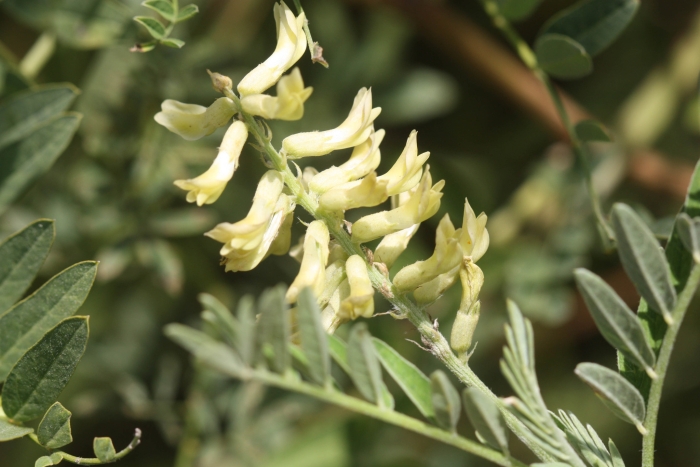Canadian Milkvetch
(Astragalus canadensis)
Canadian Milkvetch (Astragalus canadensis)
/
/

Scott Loarie
Public Domain
Image By:
Scott Loarie
Recorded By:
Copyright:
Public Domain
Copyright Notice:
Photo by: Scott Loarie | License Type: Public Domain | License URL: http://creativecommons.org/publicdomain/zero/1.0/ | Rights Holder: Scott Loarie | Publisher: iNaturalist | Date Created: 2018-07-28T12:29:50-07:00 |


















































Estimated Native Range
Summary
Astragalus canadensis, commonly known as Canadian Milkvetch, is a deciduous perennial herb that thrives in a variety of habitats including prairies, open woodlands, and along streambanks in much of the USA and Southern Canada. It typically grows to a height of 1-3 feet (30-90 cm) and spreads to a similar width. The plant features compound leaves with pairs of leaflets, each leaflet reaching up to 3 centimeters in length. During the flowering season, which occurs from June to August, Canadian Milkvetch produces showy inflorescences of tubular, greenish-white flowers that are attractive to pollinators. After flowering, it forms beanlike fruits within elongated pods that create a rattling sound when dry, adding auditory interest to the garden.
Canadian Milkvetch is valued for its adaptability to various soil conditions and its ability to fix nitrogen, improving soil fertility. It is often used in restoration projects, native plant gardens, and as a component in pollinator-friendly landscapes. While it prefers part shade to full sun, it is tolerant of a range of light conditions and requires medium amounts of water with well-drained soil. It is not commonly afflicted by diseases or pests, making it a low-maintenance option for gardeners. However, it can be slow to establish and may require patience in the initial years.CC BY-SA 4.0
Canadian Milkvetch is valued for its adaptability to various soil conditions and its ability to fix nitrogen, improving soil fertility. It is often used in restoration projects, native plant gardens, and as a component in pollinator-friendly landscapes. While it prefers part shade to full sun, it is tolerant of a range of light conditions and requires medium amounts of water with well-drained soil. It is not commonly afflicted by diseases or pests, making it a low-maintenance option for gardeners. However, it can be slow to establish and may require patience in the initial years.CC BY-SA 4.0
Plant Description
- Plant Type: Herb
- Height: 1-3 feet
- Width: 0.333-1 feet
- Growth Rate: Moderate
- Flower Color: Cream, Green
- Flowering Season: Summer
- Leaf Retention: Deciduous
Growth Requirements
- Sun: Full Sun, Part Shade
- Water: Medium
- Drainage: Medium, Slow
Common Uses
Bee Garden, Bird Garden, Butterfly Garden, Fire Resistant, Hummingbird Garden, Low Maintenance, Salt Tolerant, Showy Flowers, Water Garden
Natural Habitat
Prairies, open woodlands, and streambanks
Other Names
Common Names: Canada Milk-Vetch , Canadian Milk-Vetch , Astragale Du Canada , Kolvvedel , Canada Milkvetch
Scientific Names: Astragalus canadensis , Astragalus spicatus , Astragalus tristis , Phaca canadensis , Solenotus canadensis , Tragacantha canadensis
GBIF Accepted Name: Astragalus canadensis L.